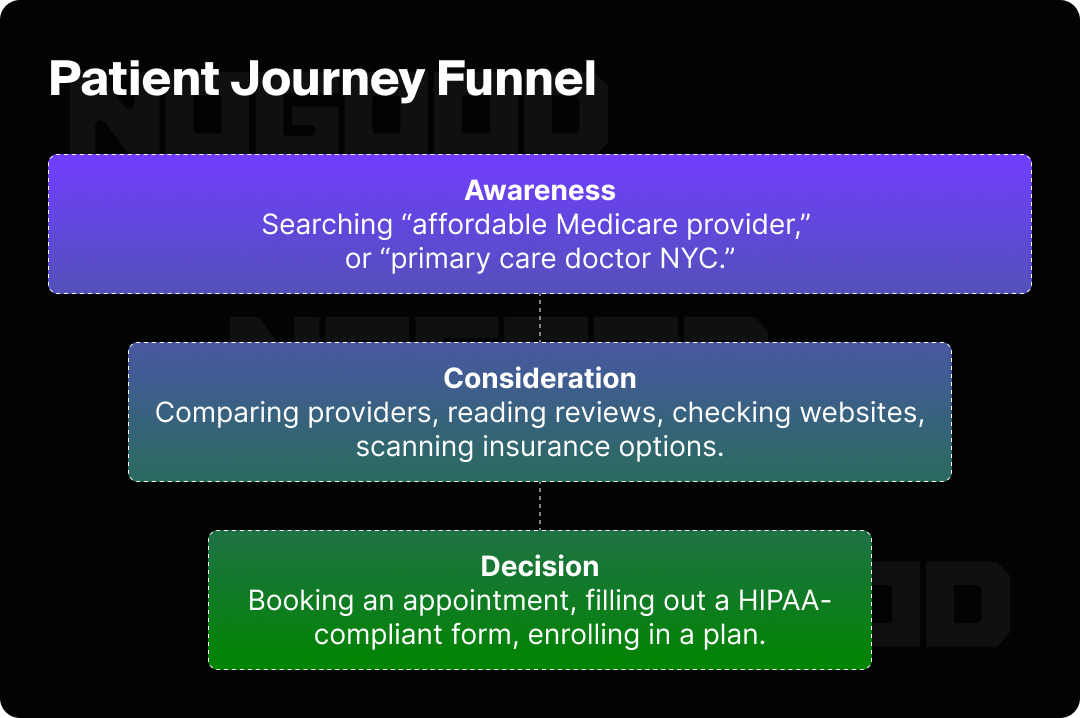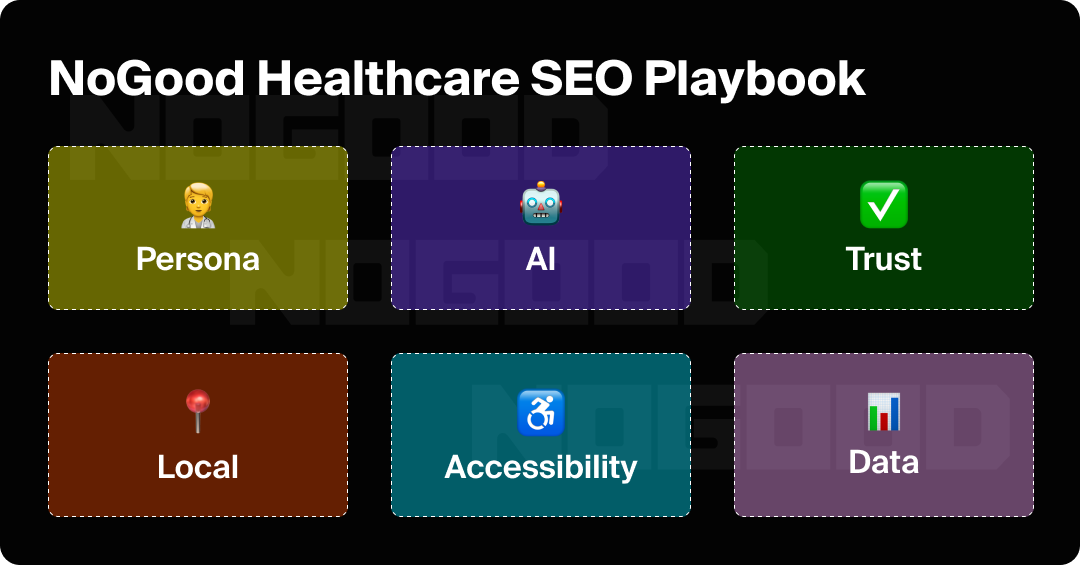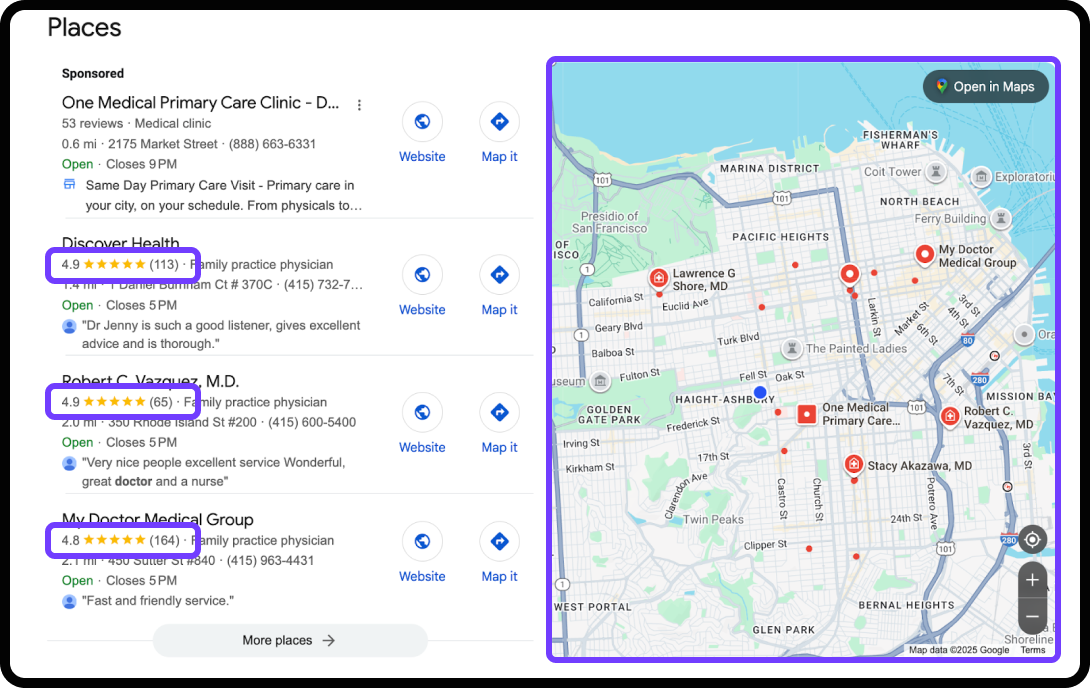Over 60% of patients perform searches before booking an appointment. That means that long before anyone steps foot in your office or even reaches your website, they’ve already Googled your reputation, compared you to competitors, and maybe even asked ChatGPT for a second opinion. If you’re not showing up in those moments, you’re losing patients before you ever even meet them.
Healthcare SEO isn’t like regular SEO. Google (and now AI engines) hold healthcare sites to stricter standards than almost any other industry; the stakes aren’t clicks or conversions. They’re people’s health.
That’s why the same generic “SEO checklist” that other agencies recycle won’t suffice here. At NoGood, we don’t just optimize websites; we engineer patient trust, algorithm confidence, and visibility across Google, maps, reviews, and AI. While other agencies are still trying to rank, we’re already making healthcare brands unavoidable.
Why Healthcare SEO Isn’t Like Regular SEO
If you’re trying to rank a DTC skincare brand, congrats; your biggest hurdle is likely fighting off 10,000 other serums promising “glow in a bottle.” But if you’re in healthcare? It’s a different ballgame. You’re not just competing with other practices and services, but also competing with Google’s trust issues, HIPAA lawyers and compliance experts, and a patient base that would rather scroll WebMD at 3 a.m. than call your office.
The thing is, healthcare SEO doesn’t play by the same rules as other industries.
- YMYL + H-E-E-A-T: In Google’s eyes, healthcare content falls under “Your Money or Your Life.” Translation: you’re held to a higher standard because the stakes aren’t just clicks, but people’s actual lives. That means every page must ooze expertise, authority, and trust (and yes, that means author bios, citations, and medical reviewers).
- Compliance minefields: In most industries, you can push boundaries with creative copy (my bread and butter). But in healthcare, a single misplaced claim can land you in hot water. HIPAA, accessibility, and disclaimers are essential.
- Local + reputation first: Patients aren’t browsing providers like how they browse for sneakers. They read reviews, check map packs, and see who is nearby. Your Google Business Profile and online reputation are the real front door to practices and other medical/healthcare services.
- Experience expectations: If your site loads slower than a patient portal on dial-up, you’re out. Today’s patients expect fast, mobile-friendly, intuitive websites that don’t feel like they were built in 2009.
The bottom line is, you can’t use the same SEO playbook as an eCommerce brand because that’s a shortcut to losing. Healthcare SEO isn’t about vanity metrics like chasing traffic. The goal is to build trust, visibility, and credibility to win patients and satisfy algorithms that are going to judge you harder than a class of middle schoolers.
Real-World Examples: Healthcare SEO in Action
- Cleveland Clinic vs. “Dr. Blogspot”: Cleveland Clinic dominates because every article has a doctor’s byline and journal citations. Smaller practices still posting “5 Tips for Healthy Skin” with no attribution don’t stand a chance.
- The Diabetes Startup That Tanked: A health-tech brand published blogs with unverified claims → flagged and de-ranked. Their competitor, who stuck to peer-reviewed info, quietly climbed to the top.
- Reviews > Billboards: A New York clinic with 500+ glowing reviews consistently outranks bigger competitors with fancier sites but weak reputations. Patients trust other patients, period.
- The Site Speed Disaster: One practice lost conversions simply because their site wouldn’t load on mobile. Patients clicked, waited, and bounced. That’s the cost of ignoring UX. If you’ve ever dealt with a mobile insurance portal, you know what I’m talking about.
The Real Growth Levers in Healthcare SEO
Most agencies will tell you that healthcare SEO is about “optimizing keywords” and “posting more content.” But unfortunately, that’s the bare minimum. If you want to drive patient acquisition and revenue, it demands pulling the right levers: the ones that matter in your niche of the healthcare industry.
- Persona-driven SEO: “Patients” aren’t one monolithic group. A cardiology clinic’s audience doesn’t behave like a telehealth startup’s. If you don’t build strategies around real patient personas (their fears, questions, and search behavior) you’re optimizing in the dark.
- AI + AEO visibility: Google isn’t the only search game anymore. Patients are asking ChatGPT, Gemini, and Perplexity who to trust. If your brand isn’t showing up in those answers, you’re invisible. Citations and mentions in AI-generated results are the new SERP rankings.
- Trust-first content: Author bios. Cited medical sources. Reviewed by practitioners. In healthcare, it’s not optional; it’s your ticket to proving H-E-E-A-T. Think of every blog post as both patient education and a trust signal to algorithms.
- Local SEO done right: Your map pack presence and review game determine if patients ever make it to your website. A polished Google Business Profile + proactive review strategy is often more powerful than the fanciest blog post.
- Accessibility as SEO: Google (and patients) notice if your site isn’t built for everyone. WCAG compliance, responsive design, and mobile-first usability are now direct ranking and conversion factors.
Healthcare SEO is not about chasing traffic for traffic’s sake. You’re building a visibility system that consistently attracts the right patients and makes Google and AI engines treat you like the authority that you are.
The Patient Journey: Why These Factors Actually Matter

It’s easy to get lost in acronyms like AEO, H-E-E-A-T, and WCAG (Web Content Accessibility Guidelines). But here’s the real question: how does a patient actually find you?
- Awareness: A need pops up. Maybe it’s someone considering a plastic surgeon, a parent looking for a new pediatrician, or a retiree comparing Medicare providers. Their first move? A search bar. Whether they’re Googling “best cosmetic surgeon near me” or asking ChatGPT “what’s the top-rated Medicare plan in Florida?” This is where local SEO and AI visibility decide if you’re even in the game.
- Consideration: Once options are on the table, the research begins. Patients compare providers, policies, and practices side by side. This is where reviews, site experience, and trust-first content do the heavy lifting. If one insurance agency’s site has clear plan comparisons and fast mobile booking, while another’s looks like it hasn’t been updated since 2009? Easy choice.
- Decision: The final step is action. This could look like booking an appointment, enrolling in coverage, or reaching out to a provider. Conversion-focused design, from “Book Now” buttons to HIPAA-compliant forms, determines whether that intent turns into an actual client or patient.
No matter the vertical (surgery, general practice, insurance, Medicare, or beyond) the patient journey follows the same flow. The growth levers aren’t abstract SEO tactics, but more like checkpoints in the patient journey. Miss one, and you lose the patient. Nail them all, and you’re doing more than ranking; you’re acquiring.
The 2026 Healthcare SEO Playbook (NoGood Edition)

Most agencies will give you the same old dusty checklist they use across every other industry: “Do keyword research, write blogs, get backlinks.” That’s all good and dandy, I guess, but healthcare is built differently; and so is our playbook.
We believe in building a system of trust and visibility that works for plastic surgeons, general practitioners, Medicare providers, insurers, and every healthcare brand trying to cut through the noise.
Here are the pillars of our strategy when we sign with a company in the healthcare space:
1. Build Trust Signals Into Every Page
Patients don’t trust a faceless blog; and neither do Google and major LLMs. Author bios, medical reviewer credits, citations from journals, and schema markup all scream credibility. Your content needs to look like it could hold up in a courtroom, not just on a blog roll.
2. Optimize for AI Search, Not Just Google
Patients aren’t only asking questions on Google anymore. Don’t lie, I know you’ve probably looked up a symptom or two. Users are asking ChatGPT about Medicare plans, or Gemini about “best telehealth platforms.” If you’re not optimized to show up in AI answers, you’re invisible.
That means citations, mentions, and structuring your content for AEO (Answer Engine Optimization).
3. Make Local SEO + Reputation Your Lifeline

Reviews aren’t fluff in healthcare; they’re survival. Before, patients may not have had much of a say in who their doctor is, but that’s not the case today. We’re a picky bunch when it comes to our health, and rightfully so. A polished Google Business Profile, consistent NAP (Name, Address, Phone) citations, and a proactive review strategy are the new front door to your practice.
4. Design for Patients, Not Just Algorithms
Conversion-focused site architecture, mobile-first UC, and WCAG accessibility standards aren’t side quests; they’re the main game. If a patient can’t book an appointment from their phone in under 60 seconds, you may lose them to an alternative provider providing that booking convenience.
5. Create Content Models That Scale With Authority
Forget scattershot blogs. Build pillar pages and patient-centric FAQ clusters that establish topical authority. For example, a plastic surgeon builds a pillar on “breast augmentation” with clusters on recovery, risks, and costs. An insurer builds a Medicare pillar with subtopics for every state.
6. Use Data to Refine, Not Just Report
Anyone can run a Google Analytics report. What matters is how you use that data to continuously refine the patient journey, from organic discovery to booked appointment or enrollment.
That’s the difference between a regular SEO checklist and the NoGood playbook: we’re not just optimizing for clicks; we’re engineering trust, visibility, and acquisition in one system.
What Other Healthcare Marketing Agencies Won’t Tell You
Most agencies love to hand out the same cookie-cutter SEO “best practices” like it’s 2012. Sprinkle in some keywords, crank out a few blog posts, and call it a day. That’s fine if you’re selling sneakers (although we believe even a sneaker SEO strategy can use some color). But in healthcare? That approach is like showing up to surgery with a butter knife.
Here’s what they won’t tell you (but we will):
- Most are still playing for Google, not AI. They’ll celebrate your ranking in position #3 while ignoring that ChatGPT, Gemini, and Perplexity already rewired how patients get answers. We don’t just optimize for SERPs; we engineer your brand to show up in AI conversations where decisions actually happen.
- “Content is king” is outdated. Anyone can publish a blog. Not everyone can publish a medically-reviewed, schema-marked, patient-friendly article that LLMs trust enough to cite. We build content that makes you quotable to both humans and machines.
- Traffic is a vanity metric. Agencies brag about clicks. We care about conversions. Did that search turn into a booked surgery consultation, a Medicare enrollment, or an insurance lead? If not, who cares?
- Compliance isn’t a checkbox, it’s a moat. HIPAA, YMYL, WCAG; most agencies treat these like legal fine print. We treat them like growth levers. Get it right, and Google, AI engines, and patients all see you as the safer, smarter choice.
- They’re years behind. Agencies will eventually catch on to AI visibility, zero-click search, and patient-centric UX. But by the time they do, their clients are already behind. We don’t follow trends; we build the playbook.
Other agencies want to “get you ranking.” We want to make you unavoidable, whether a patient is scrolling Google, asking ChatGPT, or reading reviews. That’s the difference.
Ready to Make Your Healthcare Brand Unavoidable?
Patients aren’t waiting. They’re Googling symptoms, comparing providers, checking reviews, and even asking AI to weigh in on the right pick. And if your brand isn’t showing up in these moments with authority, clarity, and credibility; you’re already losing them to another option.
We build strategies to make healthcare businesses unmissable. From local map packs to AI citations to the moment a patient clicks “Book Now.” At NoGood, we don’t just “do SEO.” We engineer growth systems that combine patient trust, algorithm confidence, and measurable acquisition so you don’t just rank, you acquire.
If you’re ready to stop blending in and start leading in healthcare online, let’s talk. Book a strategy session with our growth team today.







